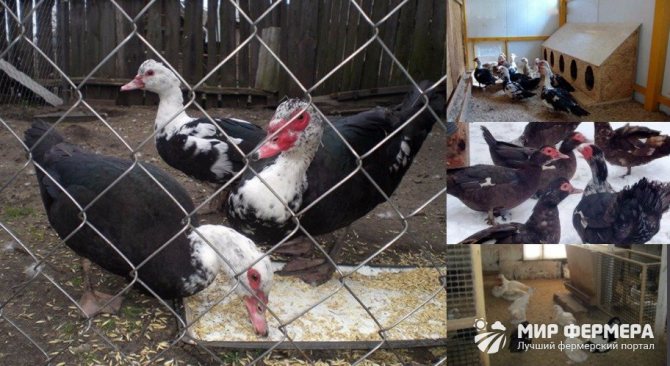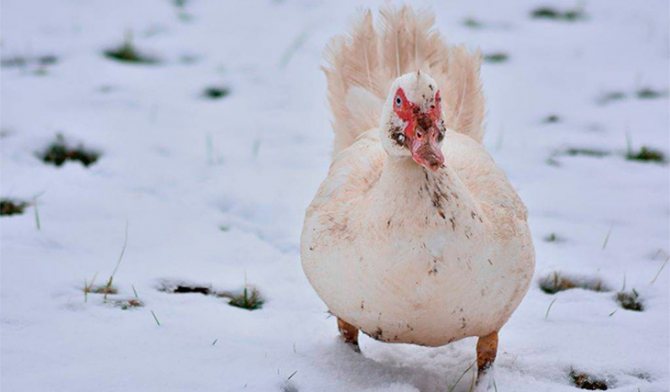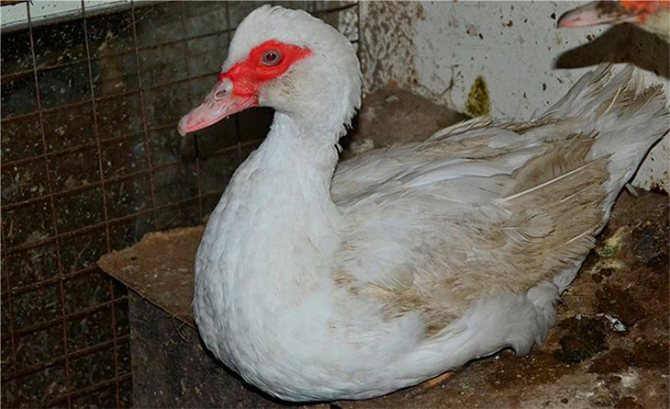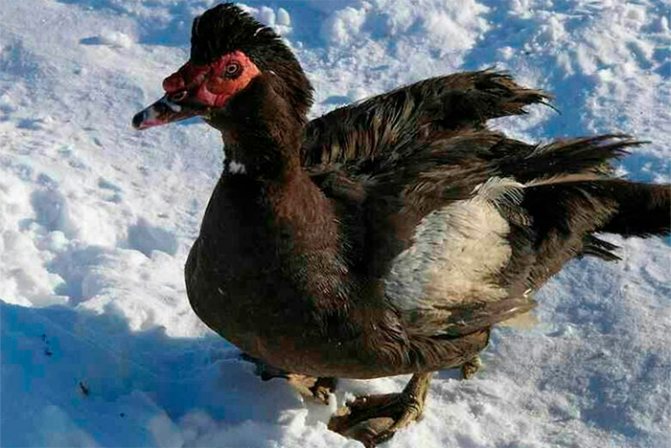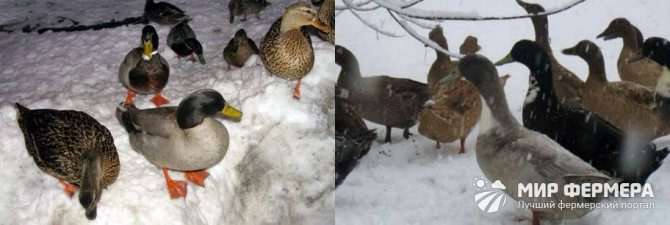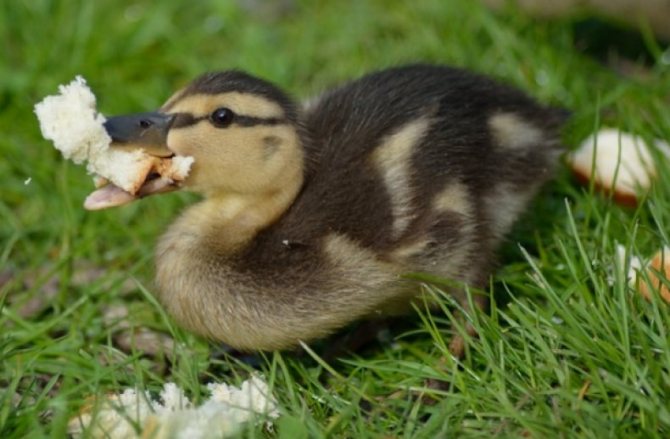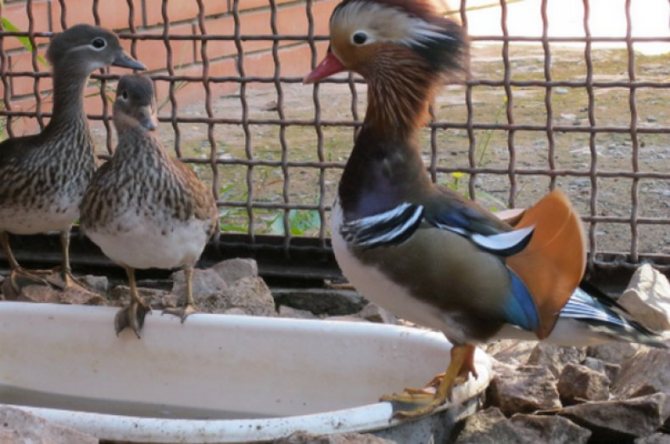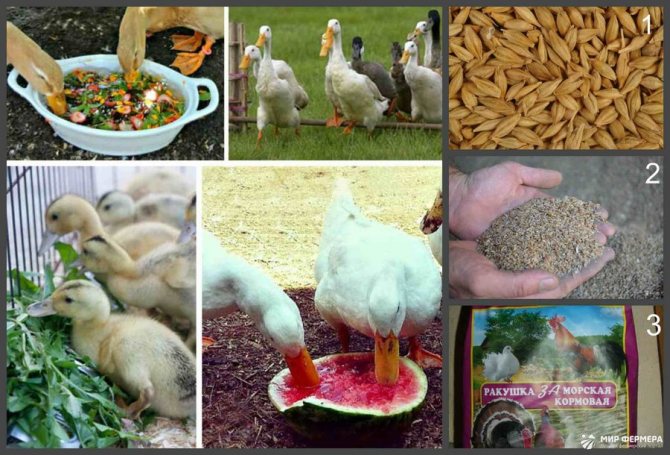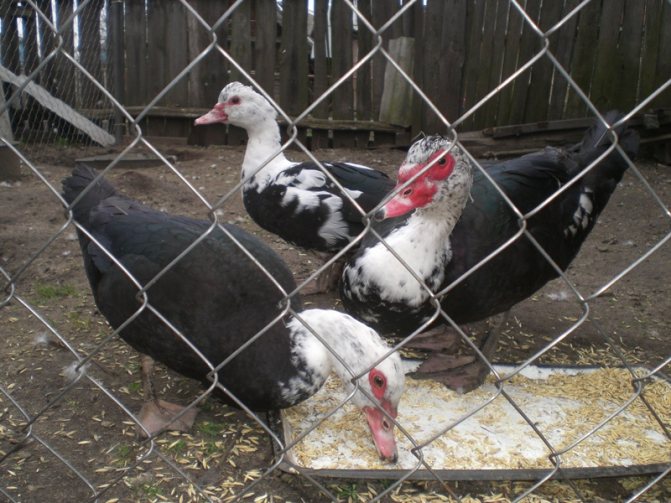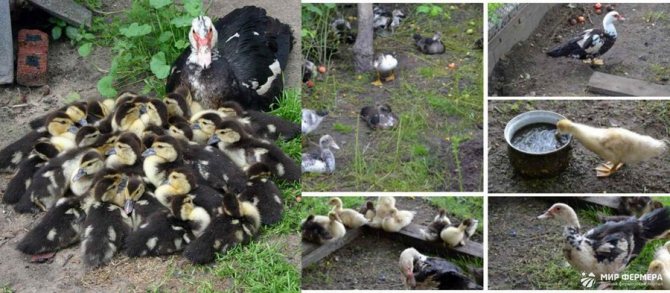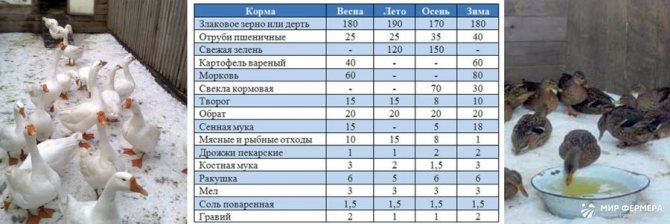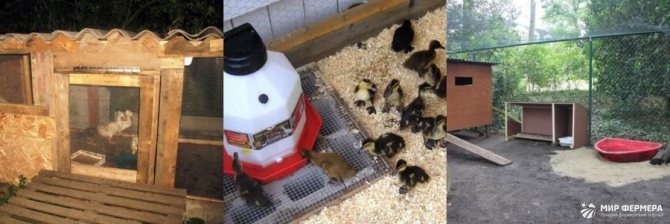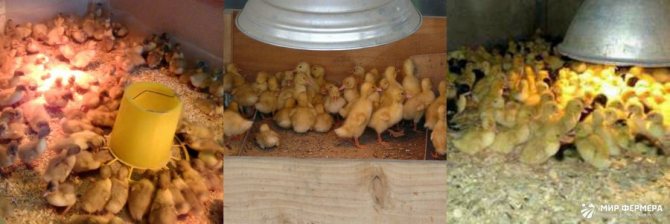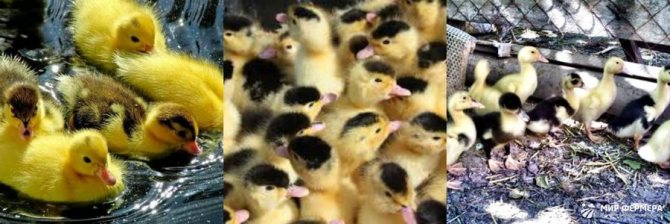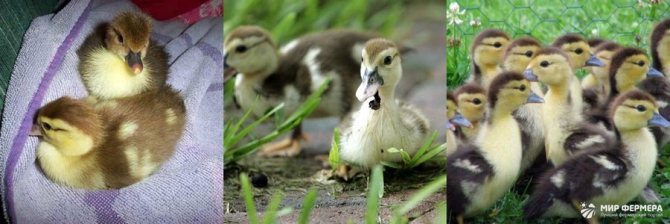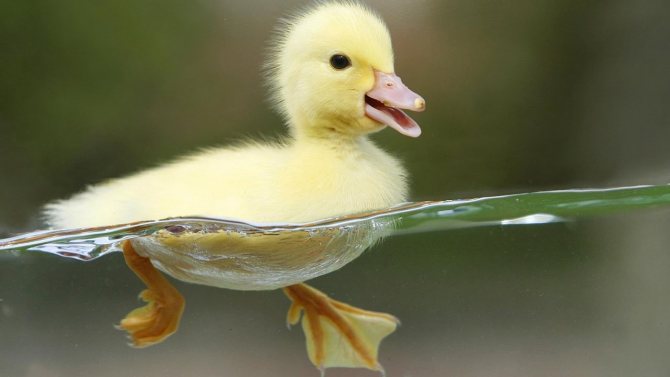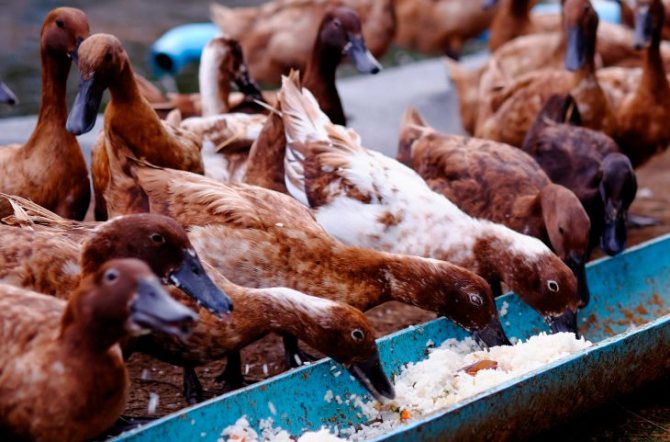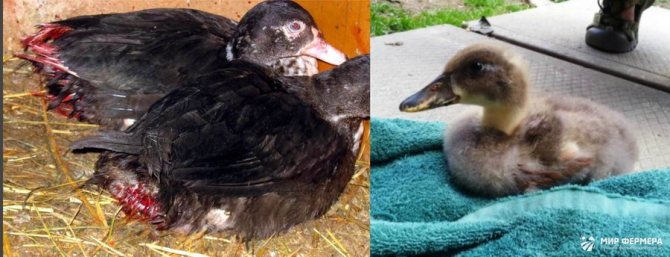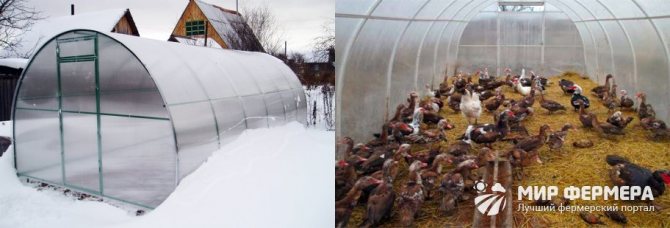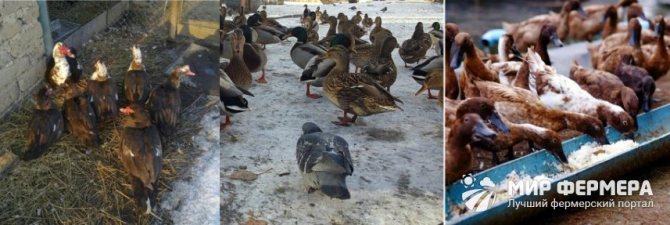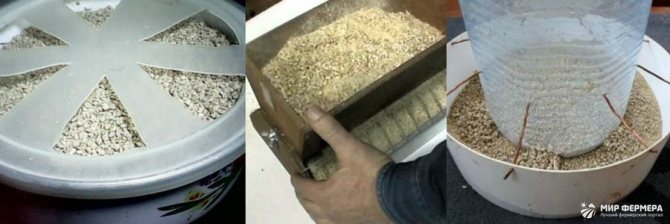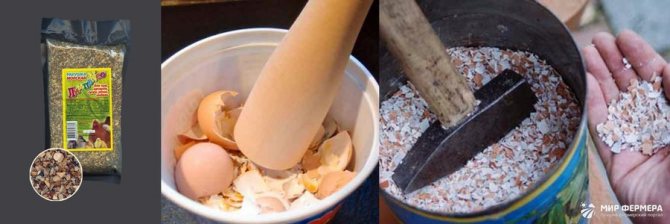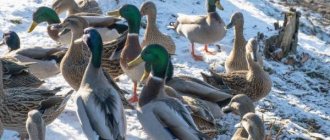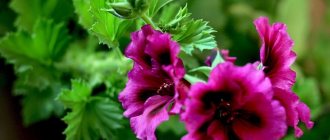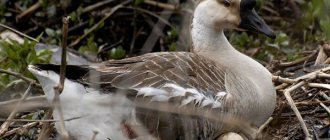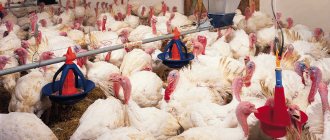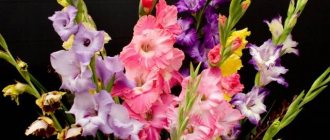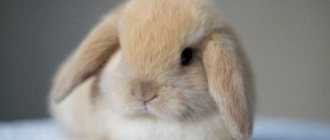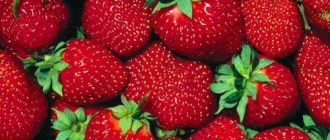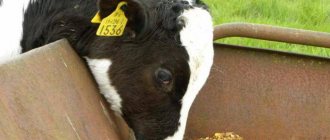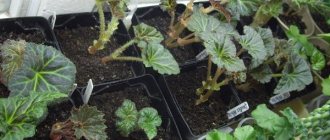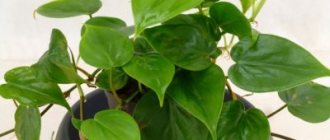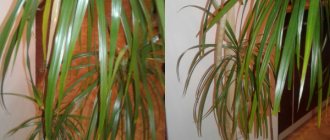How to keep Indo-duck in winter?
Indoor maintenance in winter at home should be carried out in an insulated barn or greenhouse.
It is very important to respect the spatial parameters when preparing a room for keeping duck ducks in winter. On average, 3 ducks will need 2 square meters of space.
If you plan to breed Indo-ducks seasonally, then it is quite possible to keep them with ordinary ducks, since they are very calm and not pugnacious. To keep indoor birds in winter, the poultry house must be equipped according to all standards, namely, it is good to insulate not only the walls, but also the floor in order to exclude a sharp temperature drop and drafts. And also to prevent the appearance of musty air and dampness, it is imperative to equip a ventilation system, or insert a window with a window.
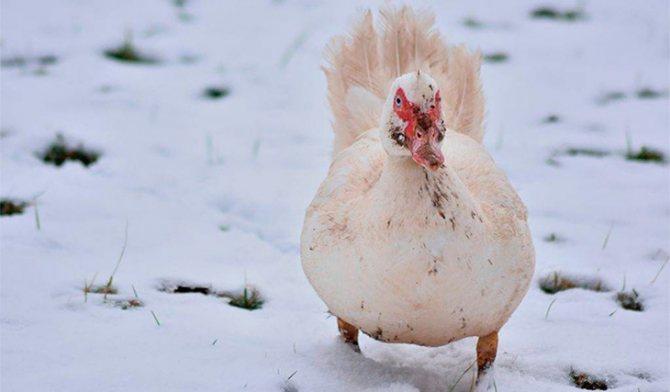
Indo-women do not tolerate a climate with low temperatures and high air humidity.
The lowest temperature that Indo-ducks withstand in winter during walking is minus 8-9 degrees of frost, and in the room for ducks the air temperature should not drop below 12 degrees Celsius.
Otherwise, this can lead to freezing of their paws and the subsequent death of individuals. Therefore, it is necessary to take care in advance about how the shed (or greenhouse) will be heated for ducks to live in it during the cold season.
In the barn
Keeping indoor dogs in winter is a complex process. The main rule in keeping such individuals is the presence of a heated poultry house. A shed for poultry of the breed in question by the time the Indo-duck begins to be driven for the winter should be well prepared and have warm walls without cracks, as well as an insulated roof and floor.
Walls can be insulated with plywood, ordinary plaster or an additional layer of wood, and quite often uses materials such as mineral wool and foam sheets for this purpose.
It is recommended to raise the floor in the barn 16-20 cm from the ground. Wood floor is considered warmer, but it is less durable than concrete.
If a plank floor is lined in the barn, then to increase its service life, you can lay sheets of old linoleum on top, which will protect the tree from excess moisture and rapid decay processes. If the floor is made of concrete, then you will need a couple of centimeters more bedding material. The litter is best made from straw or sawdust, spreading them at least 5 cm thick. As the litter becomes dirty, a new layer is simply poured on top.
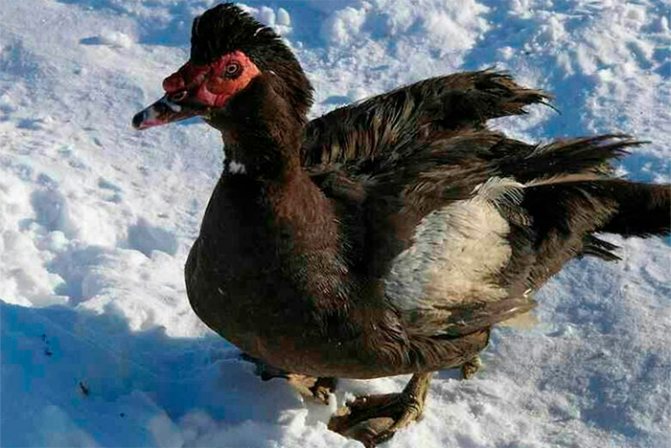

Please be aware that it is not recommended to clean the house in winter, as the decaying lower layers of litter generate heat, which creates a natural heating process, but this is accompanied by unpleasant odors.
Therefore, the shed must have a ventilation system, or a window with an opening vent. With the onset of severe frosts, the shed must be additionally heated, for this you can install:
- brick oven;
- a small potbelly stove;
- or special blue heating lamps.
The temperature in the barn for the comfortable keeping of Indo-women in winter should not be less than 12 degrees Celsius. Inside the premises should also be placed:
- feeders;
- drinkers;
- separate houses for laying eggs;
- perches in the form of logs or small inverted boxes.
In order for the birds to freely go out for a walk, it is recommended to make a special manhole in the doorway with dimensions of 40 by 40 cm and at a height of 20-25 cm from the floor. The hole itself should be closed with dense material or an opening door.
In the greenhouse
For keeping ducks in winter, many farmers create all the necessary conditions in polycarbonate greenhouses, which is also very convenient.
To keep the musk duck comfortable in winter, the greenhouse should be free of any gaps and wooden flooring should be placed on the floor. And also dry straw or sawdust should be used as bedding.
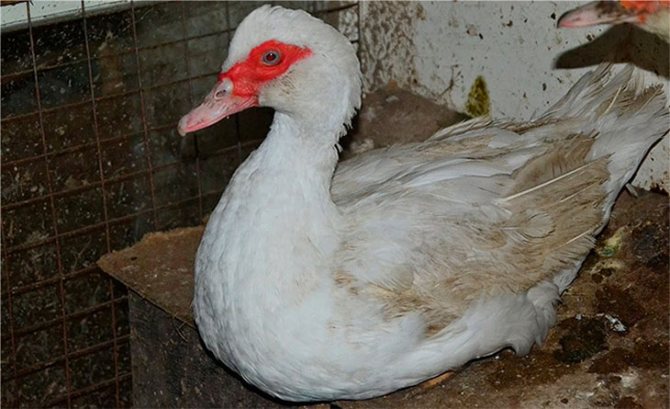

The interior of the greenhouse must be arranged exactly like in the shed, that is, there must be feeders, perches, drinkers and houses for laying eggs.
It is important to understand that it is allowed to keep Indo-duck in greenhouses only in those regions where the air temperature does not drop below 15 degrees of frost in winter. In harsher climates, birds are best kept in heated barns.
Barn heating
Despite the fact that the barn was built in compliance with all technologies and recommendations, it
need to be heated in winter... In order not to lose the bird, you need to turn on the heaters already at 5 degrees below zero. Heaters, electric fireplaces, fan heaters, electric lamps or stoves are suitable as heating devices.
Experts recommend using the simplest heating method for heating the barn - blue lamps. The power of one is 50 W, for a medium-sized shed you will need 6-7 pieces. They are installed on the ceiling, covered with a protective mesh cap.
In winter, in a barn where muscovy ducks live, the temperature should be at least 12 degrees Celsius. The room needs to be ventilated daily so that there is no musty air.
In the summer, it is not necessary to torment the bird in a capital shed, a simple board or collapsible shed is suitable for it. Indo-women do not like heat.
Feeding
The ration for feeding Indo-Ducks in winter must necessarily contain such crops as:
- barley;
- wheat;
- oats;
- corn;
- millet.
It is recommended to feed the Indo-duck with cereals in winter twice a day, in the morning and in the evening, on the basis that one bird per day should consume at least 350 grams of dry food.
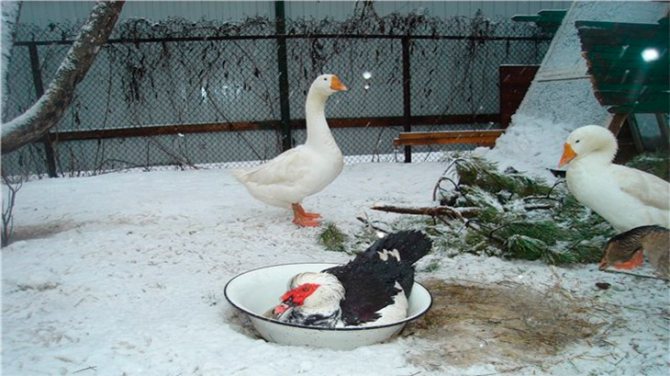

During the day, it is recommended to feed the Indo-duck at home in winter with wet mash, consisting of raw vegetable crops, in the form of chopped pumpkin, cabbage, fodder beets and carrots. It will not be superfluous to add boiled tubers or peel potatoes to the mash.
Steamed hay flour can be added to the lunch mash to increase the bioavailability of the Indo-milk diet. And the addition of meat and bone meal and fish meal will help enrich the diet with easily digestible proteins. It is recommended to add salt to the prepared mash at the rate of 1 gram of salt per bird.
It should also be noted that the composition of the winter diet of musk ducks should include mineral supplements in the form of:
- seashells;
- chalk;
- eggshell.
In the morning, Indo-women can be given food waste from the table, but they should not be sour. The water in the drinkers should be constant, and every 2 days the water should be changed and the drinkers should be washed.
Winter diet
Keeping ducks healthy in winter helps with a balanced feed ration, in which the bulk is grain. Every day for each bird in the cold season, up to 350 g of grain is required. At the same time, they eat any kind of grain, with the exception of fresh barley, which adversely affects their condition.
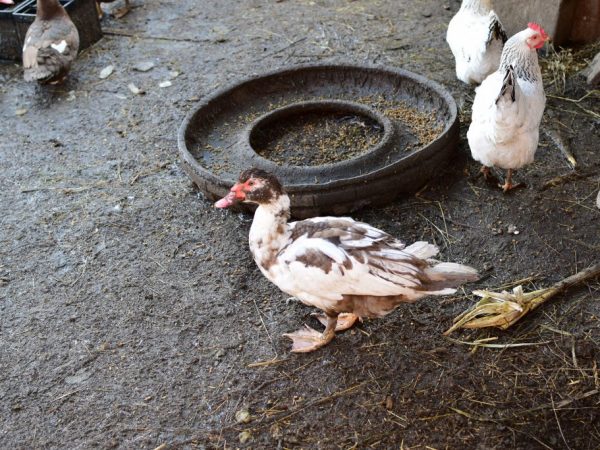

The moist food that ducks need in winter is a mixture of a large number of foods: barley, wheat bran, cottage cheese and vegetables.
For better digestibility, when feeding the ducks, barley is pre-soaked in water.
In the winter season, poultry diversify their diet:
- wet mash, consisting of bran, herbal vegetation (it is permissible to replace it with hay in winter), curd mass;
- vegetable dishes that provide vitamins, including carrots, beets, cabbage leaves, zucchini and pumpkins, it is permissible to add boiled potatoes;
- mineral additives, including table salt, shell rock, egg shells and chalk.
It is important to provide livestock with an increased amount of feed, because in cold conditions, most of the energy is spent by birds to keep warm. The average amount of feed, which is given per individual, is 0.5 kg. The amount of drinking water at room temperature per head is 1 liter. In comparison with the summer period, when the number of feedings is limited to 2, the frequency of feeding in the cold season is increased to 4 times a day. When feeding in winter, wet mash is warmed up.
Walking
Like any birds, Indo-girls must walk, breathe air. Undoubtedly, there are no special problems with walking ducks in summer, but in winter many poultry farmers ask themselves the question: "Is it possible to walk Indo-ducks in winter and how to do it?"
Fresh air is necessary for every living creature, and Indo-women are no exception, so they must be released for walking on warm winter days.
In order to keep musky ducks from freezing in winter, you should properly equip the yard for walking. The best option would be if you place it on the south side of the house and enclose it with a high netting of at least two meters or a fence.
It is recommended to release birds at an air temperature of at least minus 9-10 degrees below zero and for no more than 1.5-2 hours.
In the pen, you first need to remove the snow and all sharp-stabbing objects, and also lay a bedding of straw or sawdust so that the ducks do not injure and frostbitten their legs.
For the duration of the walk, drinkers and feeders should also be taken out to the pen. Ash baths in the fresh air will also be very useful for birds. But it is highly discouraged to admit them to reservoirs and puddles, as this can lead to frostbite of the paws and death.
Preparing a decoy duck for spring hunting
Before hunting, the decoy duck must be prepared. One of the most important moments is “buying off” the bird. That is, putting the feather in order, in which it does not get wet and allows the decoy to stay in the water for a long time.
The fall is carried out on warm spring days. The decoy is tied with a rope so that it can go ashore and process it, grease its feather with the fat of the cochlea gland. I repeat bathing from three to five times.
If the decoy is not "bought off", then on the hunt she will not have time for the drake, she will begin to freeze, reach for the shore to warm up and clean the feather.
Maintenance and care of Indo-girls at home in winter
Many owners of private farmsteads, as well as poultry farmers, are engaged in breeding musk ducks. Mostly poultry is kept in order to eat it. Some people breed poultry primarily to sell the livestock in the local market and generate income. At home, muscovy ducks are most often bred.
You should be aware that this breed of birds, like many others, lays eggs very poorly. Therefore, it is better to store them for incubation purposes. Reproduction of this breed of birds is carried out by incubating eggs. Although the duck is a bird that is good at swimming, it does not tolerate the high humidity conditions in the room in which it is kept. Therefore, special attention should be paid to keeping muscovy ducks in winter.
If we talk in general about keeping ducks in winter, then there are a number of recommendations that all people who breed Indo-Ducks in their backyard should know. In this case, you can provide a decent maintenance for this bird and get ducks with a decent weight.
Care
The main care for Indo-Ducks in winter is to implement proper feeding and maintain cleanliness in drinkers and feeders. And also weekly treat the house with disinfectants to prevent the appearance of parasites.
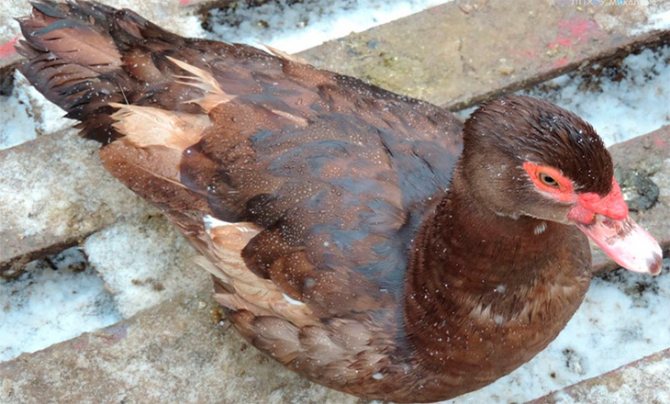

If you properly care for the Indo-Ducks at home and regularly release the bird for walking, then the individuals will grow healthy and strong, and the egg production of adult Indo-Ducks will remain at the same level as in the summer season.
Diy duck
This bird treats with special trepidation the place where the litter is located. For this reason, it is necessary to take seriously the arrangement of the poultry house with your own hands.
- The best option for his device would be a shed, which is dry and there is sufficient insulation. In order for you to have no problems when breeding ducks, you need to understand for yourself that in the room in which the bird is kept, the temperature in winter should not drop below 3 degrees.
- Indoor temperature plays an important role in breeding Indo-dogs. It is the main factor that affects the egg production of a bird. Along with chickens, duck ducks also love warmth. If the temperature drops, then individuals of this breed begin to lay fewer eggs, while ducks begin to consume large quantities of food.
- If in the barn in which the bird is kept, in addition to the low temperature, there is also dirt, as well as sufficiently humid, then the birds will feel bad in this case. You can see this by the wet plumage. In this case, it will not keep warm. This leads to the fact that the bird begins to get sick with various ailments. For this reason, the owner who breeds muscovy ducks should consider providing good housing conditions for their birds. The shed must be dry, while it must be sufficiently light.
Novice poultry farmers should understand for themselves that temperatures below 5 degrees are allowed if the barn is dry, while maintaining constant cleanliness in it. In such conditions, the duck will feel cold suddenly in the room.
If we talk about a room for keeping ducks, then anyone can be equipped for these purposes. The most important thing is that before you populate a bird there, you should plaster the walls, and then dig them well.
The latter must be done if the structure in which you are going to place the muscovy ducks is built of logs. If the walls of the barn are wooden and made of boards, then in this case you can limit yourself to upholstery and dry plaster. It is quite permissible to use plywood or cardboard for upholstering the walls of a shed for Indoor. Then you need to putty the walls, and then whitewash them. It is permissible to inhabit muscovy ducks in buildings that are built of wattle or reed. However, before settling in the bird, the walls of the ducks room should be plastered, and this must be done on both sides.
When plastering rooms from such materials with your own hands, clay is used as the main material, which is mixed with chopped straw. This is the most suitable material that will allow you to keep winter warmth in such a room. Note that adobe and adobe poultry houses keep warm the best in winter. When setting up a poultry house, you should also think about flooring. Ideally, if the floor is solid. You should also think about how rodents do not enter the room through it. Ideal if the floor is 20 cm above ground level.
Fundamental rules
Poultry breeders are advised to follow some rules when breeding ducks in winter:
- It is important to keep cleanliness. Clean the house on a regular basis.
- Even in the presence of an equipped ventilation system, it is necessary to regularly ventilate the room. In this case, you should ventilate the shed or greenhouse only when the ducks are on the walk, while trying not to create drafts.
- It is necessary to enter the poultry house carefully so as not to scare the bird.
- You can leave a slightly dim light at night.
- Ducks lay in the evening or in the morning, so if there are no eggs in the morning, they should be released for walking no earlier than 10 am.
Litter in the barn
When arranging the ducklings, you need to pay attention to the litter. The bird will feel great if you put a deep bedding on the floor. This is due to the fact that in such a lounger there is a constant decomposition of organic substances, as a result of this, heat is released in sufficient quantities. Therefore, being on such a bedding, the bird will feel quite comfortable. I have such a bedding, musky ducks will not chill outside regardless of the weather conditions.
The backlight should be completely replaced a couple of times a year. These activities are best done during the spring and fall months. Although the litter needs to be changed twice a year, the droppings should be smoothed out regularly and a new layer should be laid over the old litter.
- Peat is mainly used as the main material for bedding.
- A suitable material is sawdust or straw.
- Crushed rods can also be used for these purposes. They are obtained from the cobs of corn.
Peat litter
If we talk about peat litter, then its main advantage is that it is able to absorb a large amount of moisture - up to 8 times its own weight. Note that sawdust, most often used as bedding, is able to absorb 4 times its weight, and straw - 2 times. There is one more reason why it is worth using peat as a bedding in a duckhouse. The thing is that it has the ability to absorb air, and from it to remove gases that can negatively affect the bird.
Sawdust litter
If it is decided to use sawdust as bedding in the duckhouse, you should be aware that this material is poorly fed to the decay process compared to straw. In addition, they extract little heat. The used sawdust bedding can be further used as fertilizer. It should be remembered: in order for one muscovy duck to winter without problems and not experience any discomfort while in the house, you need 15 kg of straw to create bedding or 14 kg of peat or sawdust. Note that these standards are suitable for the regions of Central Russia. This indicator may be somewhat lower for the southern regions of our country due to milder climatic conditions.
When breeding musk ducks at home, caring for them in the winter in a duckhouse should be limited to keeping the litter clean and dry. In order to avoid a situation where harmful gases have arisen in the poultry house in an excessive amount, it is necessary to think about ventilation in the poultry house. To do this, you can lay poles on the ceiling beams. The distance between them should be kept at the level of 20 cm.
Egg production in winter
Muscovy ducks are good hens, they hatch not only their own, but also other people's eggs. Therefore, breeders who breed ducks, throw a few more eggs into her nest. Usually, an individual has 8-14 eggs in a clutch, but they are able to incubate up to 20 eggs, and the incubation period lasts about 5 weeks. On average, one duck lays 70 to 120 eggs per year.
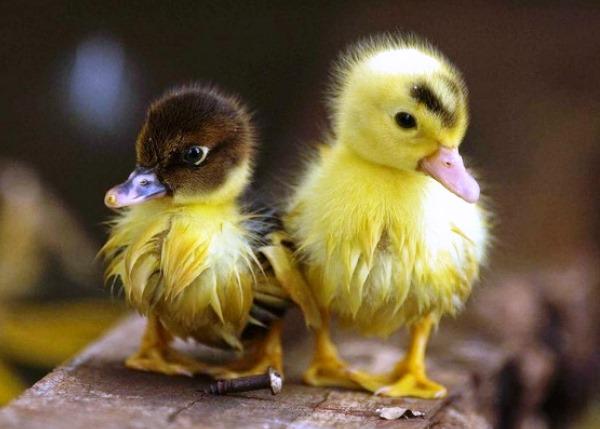

Egg production is affected by the temperature in the house - it should not fall below 12 degrees. The second important factor is the selection of individuals for mating. If the drake is 2 months older than the ducks, it is able to mate with 5 ducks. Sometimes male muscovy ducks are crossed with female Peking duck and related breeds and get high quality early maturing hybrids, the so-called mulard.
Muscovy ducks are caring birds. They hatch eggs well and raise young. But the hatched chicks must not be allowed near the female incubating the eggs. The female can succumb to instinct and abandon her offspring, walking someone else's.
How to keep ducks in winter: inventory and drinkers
In order to successfully keep an Indo-dog at home, you need to take care of the necessary equipment in advance and prepare drinkers. It is necessary to choose such a feeder so that the bird does not have the opportunity to climb into it and stain the food or trample it. For this reason, it is best to make feeders from boards with a thickness of 2.5 cm. In order to prevent birds from entering the feeder, it is necessary to install a bar on top that can be used as a handle.
It is necessary to approach the manufacture of the feeder with all seriousness. When manufacturing, it is necessary to take into account its size. It should be such that the individuals have enough food. It should be said that an adult duck should have 10 cm of a feeder.
If we talk about drinking bowls, we note that keeping water in the winter and avoiding freezing is a difficult task.
- For winter time, you can create a drinker from a trough made of wood. It can be laid on iron sheets.
- A simple solution so that the water in the drinking bowl does not freeze in winter is to build a device that will have running water. In this case, water of the required temperature will constantly flow from a large-volume tank, for example, a barrel.
An important point is the insulation of the waste pit, so that the water from the drinker flows down there and the conditions of high humidity are not created in the poultry house. When keeping indows, an important point is to move the drinkers and feeders from time to time. The need for this is due to the fact that it avoids the dirt around them. In addition, it is necessary to lay a large layer of straw 5 cm thick next to the trough to keep the trough dry.
What should be feeders and drinkers
Keeping indoor dogs in winter at home requires full preparation of the poultry house. This means the device of feeders and drinkers.
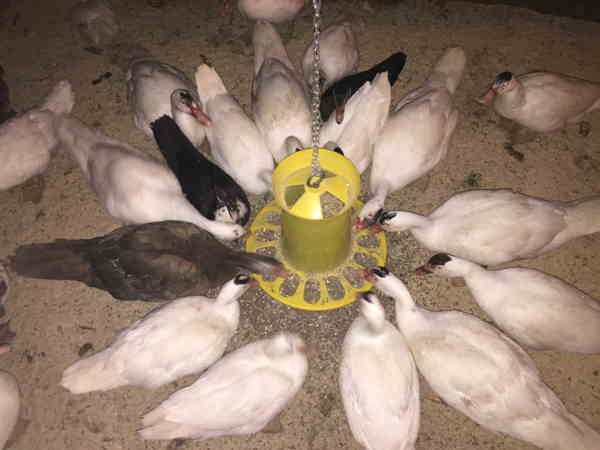

Containers for food and water should be different. They are made from any safe material, the main thing is to choose the right size and fix them well in the duck.
The size of a feeder for half a dozen birds should be 100 cm long, 30 cm wide and 10-12 cm high. The drinking bowl can be of the same dimensions, but its height should not exceed 15 cm - in this case, you can not be afraid that the birds will climb there to swim.
How to feed ducks in winter?
When breeding muscovy ducks, you need to ensure that the bird always has a wet forage mash in the feeders. In addition to it, you can use compound feed, which can be supplemented with grain. The ideal option is when there are two types of food in the duck's diet, which are combined with each other. If we talk about wet mash, then experienced poultry farmers use water for breeding when preparing them. This option is the most economical. It is best to cook them with milk. In winter, the first time you need to feed the ducks is early in the morning. Bird supper should take place before dark. Note that the first two times the bird is given a wet mash.
When feeding ducks in the winter, it is a wise decision to give a sprouted whole grain for the third meal. It is an ideal substitute for chopped greens, which are abundant.In the summer, if it is a frosty day, it is allowed to dilute the mash with warm water or lean broth. It is possible to release a bird for walking in the morning only after the feeders and drinkers are filled.
Remember to clean your duck equipment after each feed. It must be rinsed every two days using boiled water. This will prevent dirt from getting stuck in the feeders and drinkers, and will also provide the cleanliness that ducks love.
Many poultry farmers and backyard owners breed muscovy ducks. This breed of chickens is popular and its keeping conditions are simple. However, the breeding of these birds has its own nuances, which must be learned in advance. It is necessary to properly equip the poultry house so that the bird does not experience problems in the winter, and, in addition, think about the equipment - a feeder and drinker.
You should also know about what to feed the bird in the winter. One of the important points when keeping ducks in winter is to maintain a comfortable temperature for Indo-Ducks in the house, which should not drop below three degrees. The comfortable keeping of the bird and its egg production depend on this.
Breeding features
Breeding Indo-Ducks in winter is not difficult, because birds have a developed maternal instinct, and they are able to fly even at temperatures of -10 ° C.
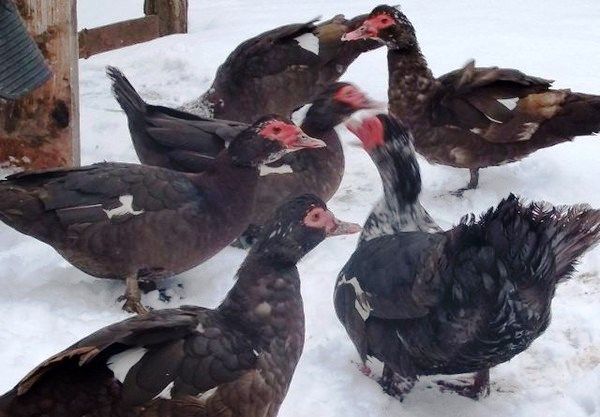

Before breeding, select in advance the females and the male who will fertilize them. The male should be healthy and 3-4 months older than the females. After the fertilization process is complete, the ducks are placed in the nests, where they lay their eggs. Females run better during long daylight hours. Artificial lamps can provide a 20-hour stream of light.
After the eggs hatch, it is better not to disturb the female and not to let the newborn ducklings near her from other birds, since instinct can force the brood hens to leave their eggs in order to walk the brood. Ducklings take 30–35 days to form.
Young growth develops better at a temperature of + 20 ... + 23 ° C. In the first days after the appearance of ducklings, special care should be taken: teach them to eat, carefully examine each chick, and transplant weaker individuals into a separate box in order to take care of them more diligently.
As for feeding, in the early days they prefer soft foods: milk, cereals, eggs, soft cottage cheese. In the future, the diet is complicated and increased by adding grains and greens. At the age of 4 weeks, young animals should already eat according to the diet of adult birds.
Who is an Indo-woman and why does she like warmth
Indo-ducks are muscovy ducks that are bred in captivity. Today, there are two main theories about what gave the name to these birds. One of them is associated with the historical habitat of birds. The largest populations of Indo-Ducks are recorded in Colombia and Mexico. The Muisca tribe used to live in these territories. Muscovy ducks were the main food of these Indians, hence the name.
Another theory is "Moscow". During the reign of Elizabeth, Latin Americans supplied these birds to Europe for the purpose of breeding them in a different climate. In the historical chronicle, the deliveries were named "Moscovy company".
Many people believe that Indo-Ducks are a mixture of ducks and turkeys. This assumption does not have any supporting facts. "Indo" only indicates that the bird comes from South America, which was inhabited by the Indians several centuries ago.
The high air temperature of the main habitat of birds played an important role in their breeding in captivity, especially in the CIS countries. In winter, they are kept in well-insulated rooms, short walks in the fresh air are organized in specially designated areas, and foods rich in vitamins and minerals are added to the birds' diet.
Features of a wild bird
Keeping these birds in captivity involves creating conditions for them that are ideally close to their natural habitat. It is important not to forget that these birds will constantly strive for freedom, so they need special supervision. Be sure to clip the wings of waterfowl at an early age.
The undoubted advantage of wild ducks over domestic breeds is their strong immunity, which is developed in a bird living in freedom. Among the disadvantages, it is worth highlighting the tougher meat and their relatively small size.
But, if the diet of these birds does not differ from the diet of domestic ones, then their meat will soon acquire other taste qualities, it will become similar to ordinary duck.
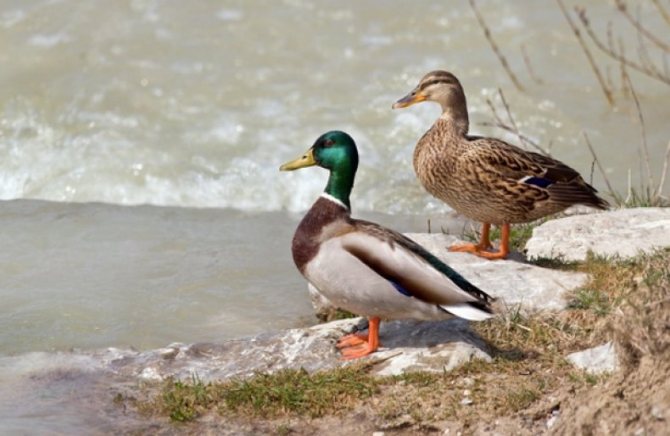

Bird care
Keeping an Indoor at home is easy and profitable.
Since the 80s of the last century, domestic poultry breeders for the first time used muscovy ducks for breeding purposes as poultry, not farm birds. It was enough just to learn the peculiarities of caring for them, such skills make it possible to raise birds. It quickly became popular to keep birds in pens and greenhouses because of the many benefits. Some of them:
- keeping indowok does not require the location of a reservoir nearby;
- the musk duck has strong immunity, which saves it from diseases that other birds suffer from;
- poultry meat is tasty and dietary;
- windocks have high egg production rates.
Those farmers who take proper care of the muscovy ducks make good profits in the form of eggs and meat. If we talk about nutrition, then Indo-duck differs little from other poultry. They also prefer to eat cereal mixes and feast on mash of cottage cheese, herbs, vegetables, chalk and other foods. But deciding to keep birds at home, you should understand some of the features of their breeding in winter.
Description of the breed
Along with nondescript relatives, the musk duck is very expressive. In addition to the variety of colors,
she is endowed with a "turkey" growth on the beak - which makes it unique and attractive.
We also recommend reading:
Gray duck: description of the bird, reproduction, nutrition Breeds of ducks for home breeding Mulardy ducks: growing at home, description of the breed, reviews Features of keeping and breeding musky duck
The Indo-duck is a large, sturdy bird, with a wide chest and strong short legs. Its body is squat, elongated, on it you can see powerful feathered wings, a thick short neck, at the end of which there is a large head. The weight of an adult drake reaches an average of 6 kg, the female will be smaller, the weight reaches 3.5 kg.
The bird is calm and not noisy, rarely gets into fights with each other. Possible conflicts with other breeds of birds. If we compare all types of waterfowl, then an Indo-woman can easily do without a reservoir, while not feeling discomfort.
The musk duck has good health and immunity, it practically does not get sick and does not need special vaccinations. If there are problems with her health, then this can only be due to her improper maintenance or a cold duckling.
Advantages:
- unpretentious to food;
- consume little feed, especially in the summer;
- it is not necessary to have a reservoir;
- the bird is calm, not noisy.
Disadvantages:
- needs a spacious room;
- in winter, the room needs to be heated;
- do not tolerate moisture, dampness and drafts;
- the feeding time is quite long - more than 2 months.
Indoor food in winter
A balanced daily diet of birds is one of the main criteria for their successful growth and performance, therefore grain is their main food. It should make up the majority of your daily diet. Each head per day accounts for up to 350 g of such food.In winter, the food remains the same.
Indo-ducks are unpretentious in food and eat any grain crops, but you should not give them fresh barley: it has a bad effect on the health of birds and may even lead to their death. It only becomes safe when soaked.
Wet food is also needed during the winter. Muscovy ducks willingly eat mash from a large number of products:
- barley;
- wheat bran;
- herbs;
- vegetables;
- cottage cheese.
Birds also need vitamins and minerals in winter. Most of them are found in vegetables:
- carrots;
- beets;
- cabbage;
- pumpkin.
Potatoes should also be added to the mash, but only boiled. Experienced farmers recommend adding natural minerals to the daily bird menu:
- table salt;
- seashells;
- a piece of chalk;
- eggshells.
You can learn how to make such mash by watching video materials on the content of such birds. Low temperatures in a pen or greenhouse that contain muscovy requires frequent water changes from the farmer. To prevent birds from catching cold, you should ensure that the water is always at least 19 ° C. Problems with the solution of these issues may not arise if the air temperature in the main place of their detention is room temperature.
Bird feeding
Rapid growth and strong immunity is only possible when the bird is properly fed and looked after.
Since the bird is constantly outdoors in summer, feed consumption during this period is significantly reduced. She nibbles grass, finds worms and insects - this is how her body receives all the nutrients, vitamins and minerals it needs.
Bird feeds on crushed grain, silage or grass, vegetables and compound feed... It is necessary to provide it with mineral and vitamin supplements, fish or meat and bone meal. There should be a special feeder in the shed, in which there will be chalk, a shell of fine fraction, gravel or sand.
Drinking bowls should always be filled with water. It needs to be washed regularly, water changed. If there are many birds, then there should not be one drinker.
Insulation of the main place of detention
On the territory of Russia and other countries of Eastern Europe in winter, outdoor thermometers regularly show temperatures below about. Severe frosts force poultry farmers to monitor their livestock more carefully. Caring for Indo-girls at this time of the year requires changes in the form of insulation of their main habitat. Despite their strong immunity, Indo-Ducks are southern birds and unaccustomed to such low temperatures. They can freeze their paws or scallops, catch a cold and even die, so the owner of muscovy ducks needs to insulate the room for the winter.
Features of the repair of the premises
Building a new poultry pen or renovating an old one takes some action from the farmer. They are associated with the main building materials that are used in the work. So, your choice should be stopped on materials that keep warm. For flooring, wood is the best option, but it is less durable than concrete. Having decided to use this natural material for covering, the floor level must be raised 10-15 cm from the ground. To prevent the boards from getting angry quickly, they should be covered with a special primer for wood and covered with linoleum.
If there is a desire in the barn to make a concrete floor, it should be well insulated. Linoleum is spread over the concrete screed, and a large layer of hay or sawdust is thrown on top. Such bedding will be good protection for birds from hypothermia. We must not forget about the walls with the ceiling of the structure. All cracks should be covered with cement or blown out with polyurethane foam. For insulation of external walls, it is best to use foam blocks: they serve as an additional layer for the walls, keeping the heat inside for a long time.
Fresh and clean air
Breeding Indo-Ducks will be beneficial and profitable only if all the rules for their care are followed.Egg production and growth of the bird itself depends on the health of the entire livestock. In winter, problems with this may appear. If birds are kept in a poorly ventilated area, they will be exposed to infectious diseases. To prevent this from happening, it is necessary to equip the shed with a ventilation system. It can be supply and exhaust and mechanical. If the floor area in the barn does not exceed 20 sq. m, it is impractical to use mechanical ventilation.
The main task of the supply and exhaust ventilation is to remove old air and replace it with fresh air drawn into the shed from the street. In these processes, it is important that the air temperature remains in the same aisles as it was before, and there are no drafts in the room itself. This requires:
- Make through windows in the opposite walls of the building so that they are located away from the birds. The exhaust window is made at the bottom, 15-20 cm from the floor, and the supply window is at the top, 10-15 cm from the ceiling. Pipes are inserted into them, facing the street.
- In order to avoid strong drafts that can harm the health of birds, it is necessary to install doors on the ventilation windows inside the barn. With their help, the air flow is regulated and completely blocked.
- The ventilation pipes are covered with "umbrellas" to protect the shed from rainwater entering.
Features of the installation of ventilation for a barn with indo are shown in a detailed video.
Indoor temperature for young ducks
Diurnal ducklings are very sensitive to ambient temperatures. You can take them out from under the duck no earlier than 30 minutes after hatching. During this time, the chicks will have time to dry out and warm up.
In the first week of life, when kept in a separate box, a temperature of 22 degrees is considered optimal. You can support it with a heating pad or lamp. Later, when transferring young stock to a common poultry house, the temperature is slightly reduced, but it should remain stable until the ducklings fully mature.
The optimum temperature is maintained in the ducklings' room, which changes every 5 days (up to 20 days of age) downward with the use of special brooders.
The temperature is measured at the level of 5 cm from the floor, at the edge of a brooder umbrella or other heater, in the area of which ducklings are usually located. In addition, the temperature should be measured at the level of 15 cm from the floor, by hanging the thermometer at a distance of 50 cm from the front wall, but so that the sun's rays do not fall on it. Here the temperature must be at least 16 ° C. Sudden changes in temperature must not be allowed.
The room for young ducks should have clean fresh air, which is achieved by periodically ventilating it, however, avoiding drafts.
The need to install heating devices
Keeping homemade musk ducklings in winter requires the farmer to control the indoor temperature. If the floor is covered with straw or sawdust and there are no drafts inside the barn, favorable conditions for the growth and productivity of birds are observed in the temperature range from 12 to 29 ° C. If the thermometer shows a lower temperature, their productivity decreases. At temperatures below -5 ° C, frostbite of the extremities is possible.
It is not difficult to save birds from frost if:
- Heat the barn with incandescent lamps.
- Heat the barn with a potbelly stove.
- Use electric heaters for heating.
- Use specialized heaters.
If you need to raise the air temperature by 1-3 °, ordinary bulbs are suitable for heating the room. If you hang them in the barn in the amount of 3-4 pieces, they will be enough to create optimal conditions for the life of birds.
The potbelly stove is considered to be more effective heating means. In one room, such a stove is capable of increasing the air temperature by 12-15 ° during its hour of operation. But do not forget about the safety of the Indo-girls themselves - the stove should be fenced off from birds.
Indoor content in winter
Features of raising ducklings
Raising ducklings depends on the purpose of breeding - for meat or for a tribe. It also depends on how to feed the day-old ducklings at home.
It is best to hatch young growth in April. During the spring and summer period, he will have time to gain sufficient body weight for slaughter. However, for optimal use of males and females, breeding is recommended in three stages: in April, July and September.
To the tribe
For breeding use young healthy females and males. It is better to keep the individuals that hatched in April. Such individuals will have time to fully grow stronger by winter and will survive the cold well.
The tribe is selected without physical defects. It is best to select at 2-3 days after hatching and 2 months after that. Feeding and keeping of individuals selected for the tribe is carried out in accordance with general recommendations.
For meat
Ducks quickly gain the weight they need for slaughter. This usually takes 2-3 months. To fatten poultry, you need to provide optimal housing conditions and balanced feeding.
For the first three weeks, young ducklings are kept in a separate warm enclosure and artificially extended daylight hours. Grain and succulent feed, root crops, green grass and aquatic vegetation are used for feeding. Be sure to include in the diet mineral supplements and animal feed.
Conditions for keeping ducks in winter: what does a breeder need to know?
Although ducks are waterfowl and have a disease-resistant immune system, farmers should devote a lot of time to prepare for the winter, to provide the individuals with optimal conditions. What are they? Here are just the main factors:
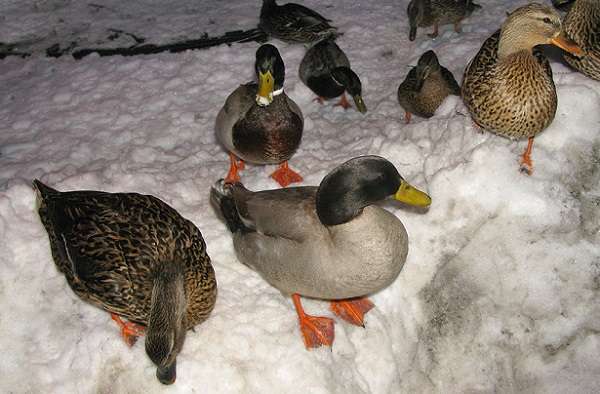

- Suitable place for wintering ducks. As a poultry house, a shed or other suitable room can be used. It must be dry and warm in it.
- Arrangement of the ducklings. Drinking bowls, feeders, perches, nests are just a small part of what a duck owner needs to take care of.
- Temperature conditions. Winter is not only a time of severe frosts, but also large fluctuations in temperature, dampness and moisture. All these factors negatively affect the birds and can cause illness in the offspring. The temperature in the duckhouse should not be allowed to drop to minus indicators.
- Good bedding.
Ducks thrive if the breeder takes care of the deep bedding. Individuals are not chilly on it, since in a sense it is a source of heat.
If the breeder decides to walk the birds in snowy weather, then it is very important to first clear the area from snow. Part of the site can be covered, for example, with straw or dried foliage.
So that keeping ducks at home in winter does not become a real problem for the breeder, he needs to prepare in advance for arranging the poultry house, create the necessary indoor microclimate, lighting and prepare a deep litter. Considering the main aspects of keeping ducks in winter, it will be possible to raise healthy birds. Continue reading at fermeru.pro.
For enriching feed with protein all the remnants of meat and fish dishes from the table, "rinsing" after washing dishes from curdled milk, whey, vegetable oil, lard, soaked sprat - everything is put into the mash.With such feeding, there is no egg beating in the chicken coop.
Geese and ducks are more undemanding to both feed and maintenance, so in winter they give the owners less trouble than chickens and turkeys. However, in January, breeding geese and ducks need to be fed more than at the beginning of winter.
They begin to lay eggs in February, and by this crucial period of their lives they should come with good nutrition. This month they are transferred to four meals a day. A damp mash is given three times a day, and sprouted grain at night. If there is compound feed, then they give it too. All this is not a waste of feed - more fertilized eggs are received, which means that more young animals will hatch by the spring.
The freedom of the bird, both in winter and in summer, is not limited. The free keeping of the bird saves the goose breeder a lot of trouble. To avoid early oviposition and early hatching of goslings, additional lighting is not used in the house. All old geese begin it in the last ten days of February, and young ones one to two weeks later.
This period is more desirable for the poultry farmer - closer to warmth.
Most poultry breeders do not consider it necessary to water geese and ducks in winter, they think: they will have enough snow, and they will have enough. Snow can replace drinking to some extent, but they still need water - they wash their beak with it and when they clear their nasal openings, they feel better.
On frosty days, poultry drinking becomes more difficult. In cold sheds, the water freezes, and the bird is mainly kept in such sheds. In practice, poultry farmers use heated drinkers', a pot with hot water is placed on the bottom in a small cabinet with a hole for poking the bird's head, and a drinker is placed on top, opposite the hole. A warm drink attracts the bird and is a good thirst quencher. It is useful to refuel such a drinker after feeding (fig. 1). In case of light frosts, the drinking water does not need to be heated. In these cases, a wooden circle is placed in the water, almost the size of the vessel. A hole is made in the middle of the circle. The floating piece of wood prevents the water from freezing and the bird drinks through the hole.
Many breeders prefer to breed ducks: some for personal needs, others for sale, but both especially value the high nutritional value of the meat and eggs of these birds. As a rule, farmers opt for musk or Peking ducks. And although these are waterfowl, the conditions for keeping ducks in the winter at home should completely exclude moisture. In general, the specifics of wintering ducks comes down to following certain rules, which are especially important for novice breeders to know about.
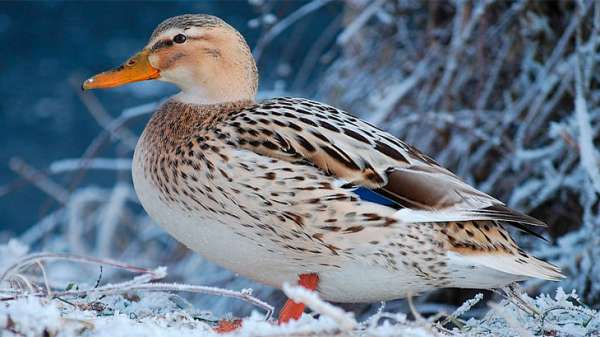

Conditions for keeping ducks in winter: what does a breeder need to know?
Although ducks are waterfowl and have a disease-resistant immune system, farmers should devote a lot of time to prepare for the winter, to provide the individuals with optimal conditions. What are they? Here are just the main factors:
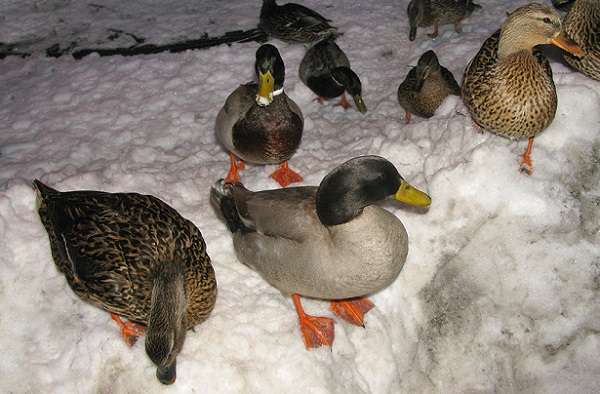

- Suitable place for wintering ducks. As a poultry house, a shed or other suitable room can be used. It must be dry and warm in it.
- Arrangement of the ducklings. Drinking bowls, feeders, perches, nests are just a small part of what a duck owner needs to take care of.
- Temperature conditions. Winter is not only a time of severe frosts, but also large fluctuations in temperature, dampness and moisture. All these factors negatively affect the birds and can cause illness in the offspring. The temperature in the duckhouse should not be allowed to drop to minus indicators.
- Good bedding. Ducks thrive if the breeder takes care of the deep bedding. Individuals are not chilly on it, since in a sense it is a source of heat.
- Cleanliness of birds and poultry house. A duck is a waterfowl, so it would be wise to give it plenty of enjoyment, for example, in an ice-hole, non-freezing pond, and it is also important to keep the feeders, drinkers and other equipment used by the farmer to keep the ducks clean.
- Specificity of food.
Severe cold and frost is a reason to diversify the diet of birds. In harsh winters, many breeders dilute the mash with warm water and meat broth, and also give the ducks sprouted grain.
- Correct organization of artificial lighting. Light plays an important role in egg-laying and weight gain. Daylight hours for birds should last at least 9 hours.
If the breeder decides to walk the birds in snowy weather, then it is very important to first clear the area from snow. Part of the site can be covered, for example, with straw or dried foliage.
So that keeping ducks at home in winter does not become a real problem for the breeder, he needs to prepare in advance for arranging the poultry house, create the necessary indoor microclimate, lighting and prepare a deep litter. Considering the main aspects of keeping ducks in winter, it will be possible to raise healthy birds. Continue reading at fermeru.pro.
Ducks are quite unpretentious birds that do not need emergency care and care. But some aspects still need to be considered. Keeping ducks at home in winter is a simple process, but it takes time and effort. Therefore, for an activity to be rewarding, there are important factors to consider.
Which breed to choose
It is best to choose one breed for breeding this category of birds. Since representatives of different species of wild ducks require individual care.
Most popular breeds:
- mallard duck. One of the favorite breeds for keeping in poultry houses. Due to its large size (the weight of an adult can reach 2 kilograms) and unpretentiousness, the mallard has become a favorite of farmers.
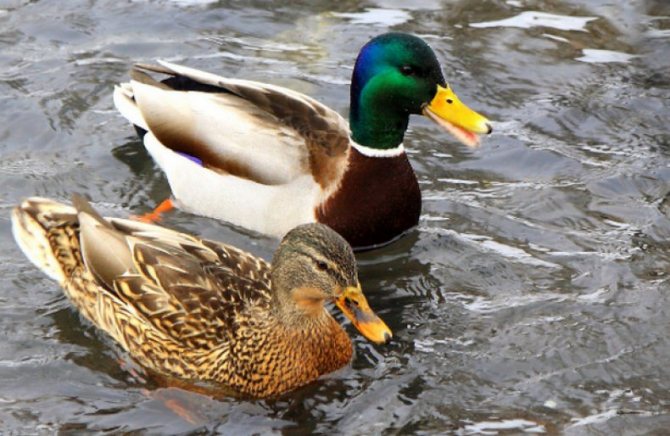

In order for the mallard to feel comfortable, it needs to provide constant access to the reservoir. Even in winter, these birds are happy to arrange water procedures for themselves; - red-headed duck. This breed is notable for its small size, the weight of drakes and a female does not differ much and is about 1.2 kg.

